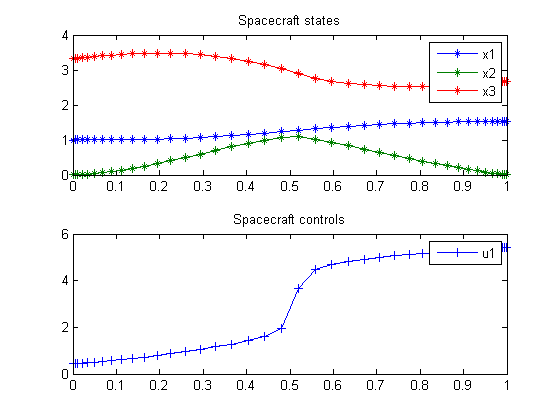Max Radius Orbit Transfer
Contents
Problem description
Maximum radius orbit transfer of a spacecraft.
Applied Optimal Control, Bryson & Ho, 1975. Example on pages 66-69.
Programmers: Gerard Van Willigenburg (Wageningen University) Willem De Koning (retired from Delft University of Technology)
% Copyright (c) 2009-2009 by Tomlab Optimization Inc.
Problem setup
% Array with consecutive number of collocation points narr = [20 40]; toms t; tf = 1; % Fixed final time for n=narr
p = tomPhase('p', t, 0, tf, n); setPhase(p) tomStates x1 x2 x3 tomControls u1 % Parameters r0 = 1; mu = 11; th = 1.55; m0 = 1; rm0 = -0.25; % Initial state xi=[r0; 0; sqrt(mu/r0)]; % Initial guess if n==narr(1) x0 = {icollocate({x1 == xi(1); x2 == xi(2); x3 == xi(3)}) collocate({u1 == 0})}; else x0 = {icollocate({x1 == xopt1; x2 == xopt2; x3 == xopt3}) collocate({u1 == uopt1})}; end % Boundary constraints cbnd = {initial({x1 == xi(1); x2 == xi(2); x3 == xi(3)}) final({x3 == sqrt(mu/x1); x2 == 0})}; % ODEs and path constraints dx1 = x2; dx2 = x3.*x3./x1-mu./(x1.*x1)+th*sin(u1)./(m0+rm0*t); dx3 = -x2.*x3./x1+th*cos(u1)./(m0+rm0*t); ceq = collocate({ dot(x1) == dx1 dot(x2) == dx2 dot(x3) == dx3}); % Objective objective = -final(x1);
Solve the problem
options = struct;
options.name = 'Spacecraft';
solution = ezsolve(objective, {cbnd, ceq}, x0, options);
xopt1 = subs(x1,solution);
xopt2 = subs(x2,solution);
xopt3 = subs(x3,solution);
uopt1 = subs(u1,solution);
Problem type appears to be: lpcon
===== * * * =================================================================== * * *
TOMLAB - Tomlab Optimization Inc. Development license 999001. Valid to 2010-02-05
=====================================================================================
Problem: --- 1: Spacecraft f_k -1.526286384516587700
sum(|constr|) 0.000000347889260101
f(x_k) + sum(|constr|) -1.526286036627327600
f(x_0) -0.999999999999998220
Solver: snopt. EXIT=0. INFORM=1.
SNOPT 7.2-5 NLP code
Optimality conditions satisfied
FuncEv 1 ConstrEv 37 ConJacEv 37 Iter 20 MinorIter 69
CPU time: 0.125000 sec. Elapsed time: 0.125000 sec.
Problem type appears to be: lpcon
===== * * * =================================================================== * * *
TOMLAB - Tomlab Optimization Inc. Development license 999001. Valid to 2010-02-05
=====================================================================================
Problem: --- 1: Spacecraft f_k -1.526020723222379500
sum(|constr|) 0.000000732944259713
f(x_k) + sum(|constr|) -1.526019990278119700
f(x_0) -1.526286384516577500
Solver: snopt. EXIT=0. INFORM=1.
SNOPT 7.2-5 NLP code
Optimality conditions satisfied
FuncEv 1 ConstrEv 132 ConJacEv 132 Iter 47 MinorIter 209
CPU time: 0.781250 sec. Elapsed time: 0.797000 sec.
end % Get final solution t = subs(collocate(t),solution); x1 = subs(collocate(x1),solution); x2 = subs(collocate(x2),solution); x3 = subs(collocate(x3),solution); u1 = subs(collocate(u1),solution); %Bound u1 to [0,2pi] u1 = rem(u1,2*pi); u1 = (u1<0)*2*pi+u1; % Plot final solution subplot(2,1,1) plot(t,x1,'*-',t,x2,'*-',t,x3,'*-'); legend('x1','x2','x3'); title('Spacecraft states'); subplot(2,1,2) plot(t,u1,'+-'); legend('u1'); title('Spacecraft controls');
